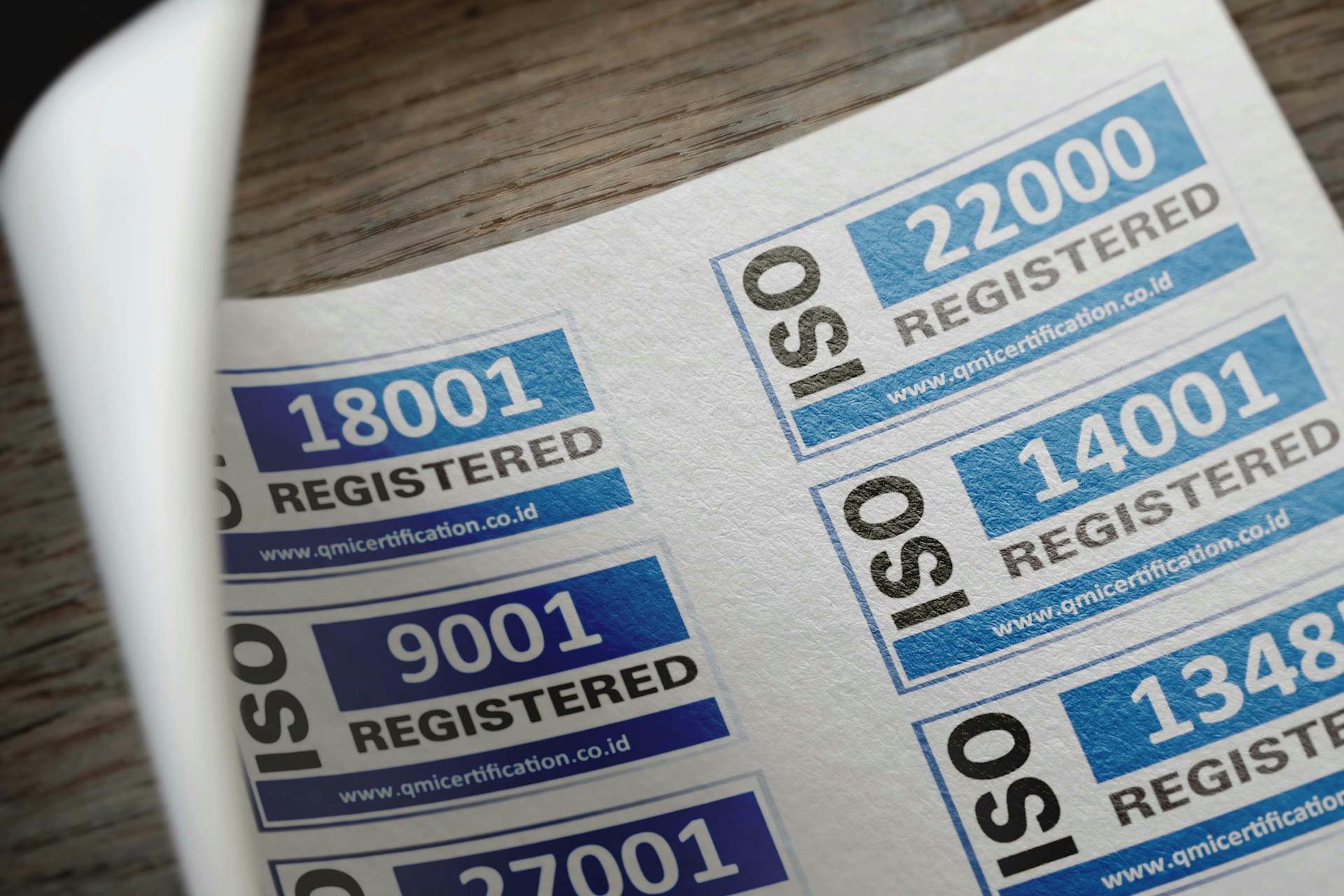
Checking an ISO certified company's compliance and standards is a crucial step in ensuring you're working with a reputable partner. This process involves verifying that the company meets the requirements outlined in the ISO standard they've been certified for.
ISO certification is not a one-time achievement, but rather an ongoing process that requires regular audits and assessments to maintain compliance. A certified company must demonstrate its ability to meet the standard's requirements through its policies, procedures, and practices.
To check an ISO certified company's compliance and standards, look for their certificate of registration, which should be issued by a recognized certification body. This certificate will list the specific standard they've been certified against and the scope of their certification.
Regular audits and assessments are a key part of maintaining ISO certification, and a certified company should be able to provide evidence of these activities, such as audit reports and corrective action plans.
Broaden your view: Mt103 Iso Version
The Benefits of Genuine ISO Certification
Getting genuine ISO certification is a game-changer for businesses. It shows that you're committed to meeting high standards around the world.
ISO certificates are more than just pieces of paper; they demonstrate your company's dedication to quality and reliability. This can help you get new opportunities and improve your reputation.
Having a genuine ISO certification can give you a competitive edge, especially when dealing with government agencies and major firms that have strict certification requirements. For example, getting ISO 9001 certification shows that you take quality very seriously.
Here are some key benefits of genuine ISO certification:
- Enhanced reputation and competitiveness
- Access to new business opportunities
- Improved quality and reliability
- Facilitated tenders and contract securing
By choosing a genuine ISO certification, you can assure clients and partners about your company's adherence to international standards. This can give you peace of mind that your partners and suppliers are genuinely certified.
Risks of Fake ISO Certification
Fake ISO certificates are more common than you might think, and the consequences can be serious. They can lead to financial loss, damage to your reputation, and even legal trouble.
Investing time and effort into a project, only to find out your certification is useless, can be a huge disappointment. It's essential to verify your certification to avoid this situation.
Fraudsters often use sophisticated tactics to create convincing fake certificates, including digital manipulation, using software like Photoshop to alter genuine certificates. They might also use unaccredited certification bodies or misleading logos.
If you suspect a certificate is fake, contact the issuing company and request their accreditation. They can confirm its authenticity or guide you in the right direction.
Here are some telltale signs of a fake ISO certificate:
- The duration of the certificate exceeds the mandatory three years
- The certificate is issued to more than one address
These signs indicate that the certification body may not have complied with the strict measures put in place by a national accreditation body.
How to Verify ISO Certification
Verifying ISO certification is a crucial step in ensuring the authenticity and validity of an ISO certificate. You can start by visiting the IAF CertSearch website to verify your ISO certificate's authenticity.
Broaden your view: ISO 4217
To verify an ISO certificate online, you'll need to gather the certificate particulars from the organization, which typically includes the ISO certificate number, the name of the organization, and the details of the certification body. The IAF website is a great resource for verifying accredited certification bodies and certified companies.
You can cross-reference the information on the certification body's official website to ensure accuracy. This will give you a clear idea of the certification body's credibility and the validity of the ISO certificate.
If you're still unsure, consult with ISO experts who can provide you with free access to top-ranked ISO experts, including certification bodies. They can help you with your questions or validation process.
Here are the steps to verify an ISO certificate online:
- Go to the IAF website and select IAF Members and Signers from the drop-down menu.
- Choose the right nation to find the certification body you're looking for.
- Check if the identity of the accreditation body on the ISO certificate is listed on the national accrediting organization's website.
- Verify the certificate's authenticity by checking the certification body's website or contacting them directly.
Remember, verifying ISO certification is essential to guarantee that organizations and individuals are engaging with authentic and certified entities. It's a vital step in upholding trust and credibility within business transactions and collaborations.
Standards and Requirements
To verify an ISO certificate, you'll typically need the ISO certificate number, the name of the organization, and the details of the certification body.
The specific information required can vary depending on the type of ISO certification being verified. For example, the certification body may require different details for ISO 9001 Certification compared to ISO 14001 Certification.
To get started with ISO certification verification, familiarize yourself with the types of certifications available, such as ISO 9001, ISO 14001, OHSAS 18001, and more.
If this caught your attention, see: Pci Dss Qsa Certification Cost
Standards
Standards are a crucial part of ensuring quality and safety in various industries. The International Organization for Standardization (ISO) has developed a range of standards that organizations can follow to demonstrate their commitment to excellence.
ISO Certification is a way for organizations to demonstrate their compliance with these standards. There are many types of ISO certifications, including ISO 9001, ISO 14001, OHSAS 18001, and ISO 27001, among others.
The hierarchy of certification is also an important aspect of standards. The International Accreditation Forum (IAF) is the highest-ranking accreditation organization, and it sets the standards for accreditation bodies around the world.
Here are the main levels of the hierarchy:
- IAF (International Accreditation Forum)
- Accreditation Board (e.g. National Accreditation Board for Certification Bodies in India)
- Certification Bodies (responsible for issuing standards certificates to enterprises and organizations)
Each country has its own accreditation board, which is responsible for overseeing the certification process within that country.
Analyze Scope
Analyzing the scope of certification is crucial to ensure it aligns with your needs.
Organizations often limit the scope of certification to a specific activity or operation, so it's essential to evaluate if the certified scope matches the services you intend to hire.
A valid ISO certificate doesn't necessarily mean it's relevant to your needs, so always check the scope of supply.
If you're receiving a certificate from another organization, verify if the scope is in line with the audit conducted.
In your own organization, ensure the identified scope is consistent with the audit results.
Broaden your view: Audit Risk Assessment Process
Sources
- https://www.itgovernanceusa.com/blog/how-to-check-if-a-company-is-iso-27001-certified
- https://certbetter.com/how-to-verify-your-iso-certificates-online/
- https://www.veritasassurance.com/verifycert.php
- https://www.siscertifications.com/how-to-check-the-validity-of-iso-certificate-online/
- https://qms-certification.com/how-to-know-if-the-iso-certificate-is-valid/
Featured Images: pexels.com

